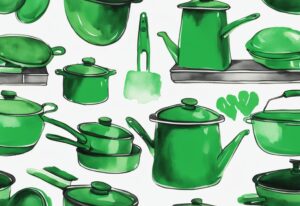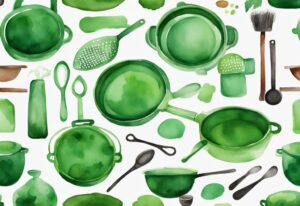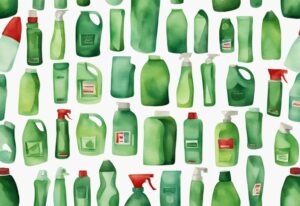Unraveling the Truth: Is Caraway Really Non Toxic? Get the Facts.
Are you confused by the myriad of claims surrounding the safety of your cookware? As a passionate advocate of non-toxic living, I understand your predicament. Is Caraway, pitched as a non-toxic cookware option, truly the safe solution you’re seeking?
In this insightful article, we’ll delve into the realm of Caraway’s integrity, unveiling the composition, research, and customer experiences that color its reputation. Will it outshine conventional non-stick alternatives? Does it truly uphold our health and the planet’s wellbeing?
Through an earnest exploration of these pivotal questions, we aim to equip you with the knowledge to make an informed decision. Stay tuned to unfold whether Caraway is the wholesome, non-toxic cookware you’ve been scouting for.
Exploring Caraway Cookware and Toxicity
The Making of Caraway Cookware: What Makes It Different?
Caraway Home has introduced itself as a non-toxic alternative to traditional non-stick cookware. This innovative cookware is crafted from high-quality ceramic-coated aluminum, which elevates its appeal. Unlike many non-stick options, Caraway cookware is completely free of harmful materials like lead and cadmium.
Its unique ceramic coating is created through sol-gel processing, a method ensuring that no toxic substances are involved. The non-stick surface, impressively, is achieved without relying on PTFE, PFOA, or PFAS—chemicals commonly found in many non-stick products and linked to various health risks. By steering clear of these harmful chemicals, Caraway offers a safer, healthier option for those aiming to reduce toxin exposure in their kitchens.
Facts Behind Caraway’s Non-Toxic Claims
The assertion that Caraway cookware is non-toxic isn’t just talk—it’s backed by rigorous testing. Certified laboratory tests have confirmed that no detectable levels of toxic heavy metals like lead and cadmium are present in the cookware, particularly in food-contact areas. This ensures its safety for everyday use.
Another crucial aspect is its environmental impact. Caraway’s production process results in up to 60% less CO2 emission compared to traditional non-stick coatings, making it a more sustainable choice. The ceramic non-stick coating of Caraway cookware is crafted from food-contact safe silicon dioxide, which further corroborates its non-toxic nature. Caraway also places a strong emphasis on sustainability in its packaging. If you’re interested in other non-toxic products, you might want to check out our recommendations for the best non-toxic room spray. The company uses recycled cardboard and biodegradable cork trivets, highlighting their commitment not just to health and safety, but also to environmental responsibility. These efforts underscore Caraway’s dedication to making a real difference, both for your health and the planet.
Decoding Toxicity Concerns in Traditional Cookware
Dangers Associated with Non-Stick Cookware
Traditional non-stick cookware carries significant health risks due to its coating materials. Often lined with substances like PTFE (Polytetrafluoroethylene), these pans can release toxic chemicals when overheated. This phenomenon, commonly known as “Teflon flu,” causes symptoms similar to the flu, including respiratory issues. Furthermore, scratched non-stick surfaces pose an additional hazard. When these coatings are damaged, toxic particles can be ingested, increasing the risk to your health.
Common Toxic Chemicals Found in Non-Stick Coatings
The Health Risks of Teflon (PTFE)
PTFE, widely recognized by its brand name Teflon, is a synthetic polymer providing non-stick properties to cookware. However, when PTFE-coated pans reach temperatures beyond 500°F (260°C), they can release harmful fumes. These fumes have been associated with various health problems, such as respiratory issues and flu-like symptoms—a condition sometimes called “polymer fume fever.”
Why Perfluorooctanoic Acid (PFOA) is a Concern?
Perfluorooctanoic Acid, or PFOA, is a chemical used in the production of Teflon and other non-stick coatings. PFOA is particularly concerning due to its links to severe health problems, including certain types of cancer and thyroid disorders. Known for its persistence in the environment and human body, PFOA continues to be a major worry among health professionals and environmentalists.
Understanding Per- and Polyfluoroalkyl Substances (PFAS)
PFAS, or Per- and Polyfluoroalkyl Substances, encompass a group of man-made chemicals, including PFOA and PFOS (Perfluorooctane Sulfonate). These substances are commonly used in non-stick cookware coatings for their ability to repel water and grease. However, PFAS are extremely persistent in both the environment and the human body, earning the name “forever chemicals.” They are linked to various health risks, such as developmental issues in children, immune system impacts, and potential carcinogenic effects.

Why Caraway Positions Itself as Non-Toxic: A Closer Look
The Science Behind Caraway’s Ceramic Coating
Caraway’s ceramic coating stands out for its use of inorganic natural ingredients, mainly silicon dioxide. This material ensures food doesn’t stick without relying on the harmful chemicals found in traditional non-stick surfaces. Through sol-gel processing, this coating is created to be free from lead, cadmium, PTFE, and PFAS.
Such meticulous crafting demonstrates that Caraway cookware answers the question, is Caraway really non-toxic, with a resounding yes.
Testing and Certifications: Proof of Caraway’s Non-Toxicity
Caraway backs its non-toxic claims with full testing reports from certified laboratories. These rigorous tests focus on harmful heavy metals, showing no detectable levels and cementing Caraway’s commitment to safety. Each test particularly highlights food-contact areas, ensuring user health remains uncompromised.
This level of testing underscores that Caraway really is non-toxic, giving peace of mind to those prioritizing their health.
Caraway Cookware: Longevity and Potential Health Concerns
Dealing with Heavy Metal Findings
Handheld XRF testing initially suggested the presence of metals like titanium and cadmium in Caraway cookware. However, subsequent detailed analysis disproved these findings.
This stringent validation process reiterates Caraway’s non-toxic promise, confirming that initial concerns were ungrounded.
What Happens When Caraway Cookware Overheats?
Despite its durability, Caraway cookware’s non-stick ceramic coating can wear away if overheated, potentially releasing materials that counter its non-toxic claim.
Thus, it’s advised to use Caraway on low to medium heat settings. This will maintain the integrity of the non-stick surface, upholding the cookware’s commitment to non-toxicity. By following these guidelines, Caraway proves itself to be non-toxic when properly used.

Real-World Reviews and Experiences with Caraway Cookware
Caraway cookware has been making waves for its bold promise of non-toxicity. Let’s explore what customers are saying and how this cookware holds up in daily use.
Customer Reactions to Caraway’s Non-Toxicity Promises
Caraway cookware has garnered significant praise for its commitment to non-toxicity. Many customers have confidently switched to Caraway, citing the reliability of the non-stick surface.
With a focus on being free from harmful chemicals, one of the most frequent positive remarks is how effective and safe the cookware is. This focus on safety resonates well with health-conscious users who appreciate the absence of PTFE, PFOA, and PFAS in their cooking utensils.
Judging Caraway Cookware’s Durability and Usability
Caraway cookware exhibits a robust design suitable for various types of stovetops, including induction, gas, and electric. Its versatility extends to oven use, withstanding temperatures up to 550°F, making it a multifaceted addition to any kitchen.
Cleaning is straightforward and user-friendly, with many users appreciating that while the cookware is dishwasher safe, hand washing is recommended to maintain its quality. However, some reviews highlight potential issues when the cookware is exposed to sudden temperature changes, which can cause cracks in the ceramic coating.
As a precaution, users are advised to avoid washing hot pans with cold water to preserve the integrity of the ceramic surface.
Answering Frequently Asked Questions
In this section, you’ll find evidence-based insights and practical tips related to the benefits and maintenance of Caraway Cookware, including its non-toxic attributes and long-term safety.
Is Caraway Cookware Truly Free of Harmful Chemicals?
Absolutely, Caraway Cookware is genuinely free of PTFE, PFOA, PFAS, lead, and cadmium. Certified testing has verified the absence of these harmful substances, ensuring no detectable levels of toxic heavy metals are present. Caraway offers a safe and non-toxic alternative in the cookware market, making it a wise choice for health-conscious individuals.
How to Maintain the Non-Toxic Properties of Your Caraway Cookware
To ensure your Caraway Cookware retains its non-toxic qualities, follow these simple guidelines:
- Avoid Overheating: Steer clear of cooking on high heat. Overheating can compromise the non-stick coating, leading to potential wear and tear.
- Cook on Low to Medium Heat: Stick to low to medium cooking temperatures. This helps in preserving the ceramic coating’s integrity and enhancing the cookware’s longevity.
- Hand Wash Only: Hand washing with a mild detergent is preferable. Avoid dishwashers, as their high heat and harsh detergents can damage your cookware.
- Avoid Sudden Temperature Changes: Refrain from washing hot cookware with cold water. This can prevent cracking and maintain the non-stick surface effectively.

What are the Findings of Long-Term Safety Studies on Ceramic-Coated Cookware?
Research indicates ceramic-coated cookware, like Caraway, is generally safe for long-term use. These coatings don’t release harmful chemicals even after prolonged usage. Although ongoing studies are promising, limited data exists on the very long-term effects. Current findings, however, support their continued safety and integrity over time, making Caraway a reliable choice for those prioritizing non-toxic cooking solutions.
Concluding Thoughts on Caraway’s Non-Toxicity Claim
Caraway cookware has positioned itself as a safer, non-toxic alternative to traditional non-stick cookware, steering clear of harmful chemicals such as PTFE, PFOA, and PFAS, but it’s important to be cautious about non-toxic claims in general. For more information on the reliability of these claims, you can read about the potential pitfalls in non-toxic cookware here. So, is Caraway really non-toxic?
The company’s commitment to non-toxicity is underscored by its use of high-quality ceramic-coated aluminum and a manufacturing process that excludes toxic materials like lead and cadmium.
Backed by certified testing, Caraway’s non-toxic claims are not just empty promises. Laboratory analyses have shown that the cookware has no detectable levels of toxic heavy metals, ensuring it is safe for food-contact surfaces.
Additionally, Caraway cookware’s ceramic coating, derived from silicon dioxide and formed using sol-gel processing, achieves a non-stick surface without resorting to harmful chemicals.
Customer reviews primarily praise Caraway cookware for reliability and non-toxicity. However, maintaining these properties is crucial. To keep your Caraway cookware at its best, you need to follow some specific guidelines. These include avoiding overheating and sudden temperature changes, which helps to preserve the integrity of the non-stick coating.
Recommendations generally include cooking on low to medium heat and hand-washing to prevent damage from dishwasher heat and detergents.
Caraway’s sustainability efforts further enhance its appeal. The company uses recycled cardboard packaging and biodegradable cork trivets, reflecting its broader mission of offering healthier, sustainable cookware options.
Ultimately, Caraway has emerged as a significant player in the non-toxic cookware market. Its commitment to eliminating harmful chemicals and prioritizing sustainability provides peace of mind to anyone seeking safer alternatives in their kitchen.
By choosing Caraway cookware, you’re not just making a healthier choice for yourself, but also for our planet.
Hi, I’m Olivia Green, the voice behind nontoxicways.com. I’m passionate about helping you make the shift to a healthier, non-toxic lifestyle without feeling overwhelmed. I love sharing my personal journey, from small changes to big transformations, along with practical tips that make it all feel doable. My goal is to inspire and guide you toward a lifestyle that benefits both your well-being and the planet. Let’s take this journey together, one simple step at a time!














Post Comment